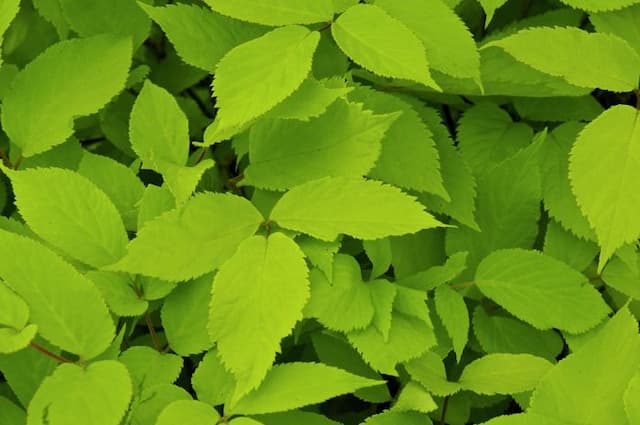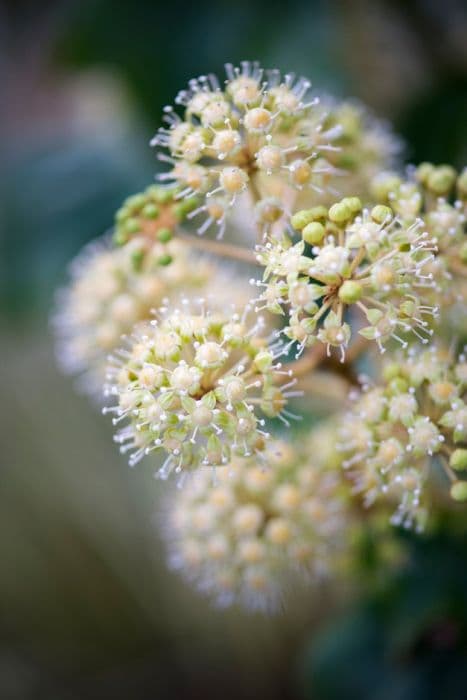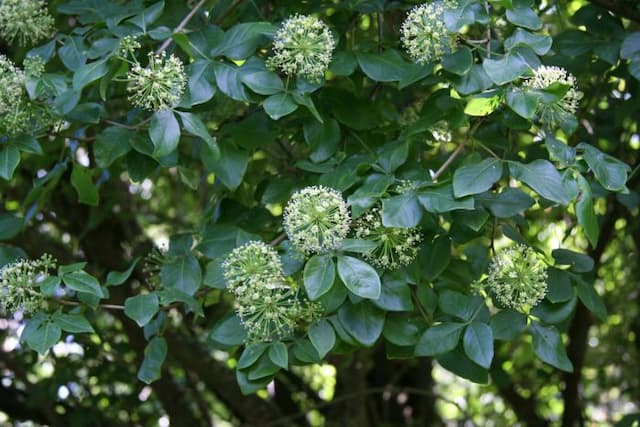Algerian Ivy Hedera algeriensis 'Ravensholst'

ABOUT
The Hedera algeriensis 'Ravensholst', more commonly known as Algerian ivy, is an attractive evergreen vine that is known for its ornamental qualities. This particular variety features large, glossy leaves that are deep green in color with prominent white or cream-colored veins. The leaves are typically heart-shaped with three to five lobes and have a leathery texture. Algerian ivy produces clusters of small, inconspicuous flowers that are usually greenish-white, but these are not as visually striking as its foliage which is used for decorative purposes in gardens and landscapes. After flowering, small black or dark blue berries may appear, which are of particular interest to birds. The plant's stems are woody, with aerial rootlets that allow it to climb and attach to a variety of surfaces, making it a popular choice for covering walls and trellises.
About this plant
 Names
NamesFamily
Araliaceae
Synonyms
Algerian Ivy, Canary Island Ivy, Madeira Ivy, Variegated Algerian Ivy
Common names
Hedera algeriensis 'Ravensholst'.
 Toxicity
ToxicityTo humans
Algerian Ivy is considered to be toxic if ingested. It contains compounds such as saponins and polyacetylene compounds, which can cause gastrointestinal distress if ingested by humans. Symptoms of poisoning may include nausea, vomiting, abdominal pain, hypersalivation, and diarrhea. In addition to GI symptoms, mucous membrane irritation can also occur, potentially leading to a burning sensation in the mouth and throat.
To pets
Algerian Ivy is toxic to pets as well. The plant contains triterpenoid saponins that can cause vomiting, diarrhea, abdominal pain, and hypersalivation if ingested. In severe cases, ingestion can lead to symptoms such as difficulty breathing, convulsions, paralysis, coma, or even death, particularly if large amounts of the plant are consumed. It is important to keep pets away from Algerian Ivy to prevent accidental ingestion.
 Characteristics
CharacteristicsLife cycle
Perennials
Foliage type
Evergreen
Color of leaves
Variegated
Height
10 feet 3 inches (3.12 meters)
Spread
10 feet 3 inches (3.12 meters)
Plant type
Climber
Hardiness zones
7
Native area
Northwest Africa
Benefits
 General Benefits
General Benefits- Ease of Care: Algerian Ivy 'Ravensholst' is a robust and hardy plant, making it easy to grow with minimal maintenance requirements.
- Fast Growth: It is a fast-growing vine, quickly covering areas such as trellises, walls, or fences, providing rapid results for landscapers and gardeners.
- Versatility in Landscaping: Algerian Ivy can be used in a variety of landscaping designs, including as a groundcover, a climbing vine, or a hanging basket plant.
- Drought Tolerance: Once established, it demonstrates a good level of drought tolerance, making it suitable for xeriscaping and areas with water restrictions.
- Tolerates Varied Lighting Conditions: It can thrive in a range of light conditions from full sun to deep shade, increasing its suitability for different garden positions.
- Erosion Control: Its dense growth habit helps to prevent soil erosion on slopes and banks.
- Seasonal Interest: Provides evergreen foliage that can enhance the garden's visual appeal throughout the year.
- Wildlife Support: While the emphasis is not on its air purifying qualities or medical properties, it can provide habitat and some support for wildlife such as birds.
 Medical Properties
Medical PropertiesThis plant is not used for medical purposes.
 Air-purifying Qualities
Air-purifying QualitiesThis plant is not specifically known for air purifying qualities.
 Other Uses
Other Uses- As a natural art medium: Algerian ivy leaves can be used to make leaf prints or patterns in nature-inspired art projects.
- In terrariums: This ivy can be planted in glass terrariums to create miniature landscapes, providing a lush green backdrop for other small plants.
- In film and theater: Due to its dense foliage, Algerian ivy can be used in set design to simulate forest scenes or to add a touch of greenery to indoor settings.
- As an educational tool: This plant can be used to teach children about climbing plants and their methods of attachment to different surfaces.
- For sound dampening: The dense foliage of Algerian ivy can help absorb sound and reduce noise levels in indoor spaces.
- As a base plant in topiaries: Gardeners may use this ivy to cover structures, forming shapes or figures as it grows and is trimmed accordingly.
- For creating shaded microclimates: By growing this ivy over arbors or trellises, gardeners can create cooler areas beneficial for shade-loving plants beneath.
- In companion planting: Algerian ivy can be used as a ground cover around taller plants to suppress weeds and retain soil moisture.
- To prevent soil erosion: This ivy can be planted on slopes where its roots help to stabilize the soil, reducing erosion during heavy rains.
- In festive decorations: Its leaves and vines can be woven into wreaths or garlands for seasonal decorative purposes.
Interesting Facts
 Feng Shui
Feng ShuiThe Algerian Ivy is not used in Feng Shui practice.
 Zodiac Sign Compitability
Zodiac Sign CompitabilityThe Algerian Ivy is not used in astrology practice.
 Plant Symbolism
Plant Symbolism- Fidelity: Algerian ivy, like other ivy species, symbolizes faithfulness and eternal loyalty, perhaps because of its nature to cling and stick firmly to surfaces.
- Friendship: The evergreen aspect of Algerian ivy can represent lasting friendship and bonds that endure through time.
- Protection: Ivy often covers walls and buildings which can symbolize a form of protection or shelter, just as it provides a shield over what it grows on.
- Survival: Due to its hardy nature, Algerian ivy can symbolize the ability to thrive and persist even in tough conditions or adversity.
- Death and Immortality: In some traditions, ivy is associated with death and the eternal life of the soul owing to its evergreen qualities and its use in wreaths and burials.
 Water
WaterAlgerian ivy should be watered deeply but infrequently, allowing the soil to dry out slightly between waterings. Generally, watering once every 7 to 10 days is sufficient, depending on the environmental conditions. When watering, thoroughly soak the soil until water runs out of the drainage holes. It’s important to avoid letting the plant sit in water as this can lead to root rot. It may require about half a gallon of water for a medium-sized pot, ensuring the entire root ball is moistened.
 Light
LightAlgerian ivy thrives in bright, indirect light but can also tolerate some shade. It's best situated in a spot that receives filtered sunlight, avoiding direct sun exposure which can scorch its leaves. A north-facing window or a position a few feet away from a south or west-facing window would provide ideal lighting conditions.
 Temperature
TemperatureAlgerian ivy prefers temperatures between 50°F and 70°F and can tolerate a minimum of about 30°F without damage. Maintain indoor temperatures above 50°F to keep the plant healthy. It's not frost-tolerant and should be protected from extreme cold to avoid leaf damage.
 Pruning
PruningAlgerian ivy benefits from regular pruning to control its growth, promote bushiness, and remove any dead or damaged foliage. Prune as needed throughout the year, but the best time for more extensive pruning is in the early spring before new growth starts. Cut back to just above a leaf node to encourage branching.
 Cleaning
CleaningAs needed
 Soil
SoilAlgerian Ivy 'Ravensholst' thrives in well-draining potting soil rich in organic material. An ideal soil mix consists of two parts peat moss or coco coir, one part perlite, and one part compost to ensure proper drainage and nutrient content. The soil pH for Algerian Ivy should be slightly acidic to neutral, between 6.0 and 7.5, for optimal growth.
 Repotting
RepottingAlgerian Ivy 'Ravensholst' should be repotted every two to three years to prevent root-bound conditions and to replenish the soil nutrients. It's best to choose a container that is one size larger than the current one to allow for adequate room for root growth.
 Humidity & Misting
Humidity & MistingAlgerian Ivy 'Ravensholst' prefers moderate to high humidity levels, with ideal humidity ranging from 40% to 60%. This plant can tolerate humidity levels slightly outside of this range but thrives best within these parameters.
 Suitable locations
Suitable locationsIndoor
Bright, indirect light with occasional misting.
Outdoor
Tolerates shade, needs protection from direct sun.
Hardiness zone
6-10 USDA
 Life cycle
Life cycleThe life cycle of Hedera algeriensis 'Ravensholst', commonly known as Algerian Ivy or 'Ravensholst' Ivy, starts with germination, where the plant emerges from seeds under appropriate moisture and temperature conditions. The seedling stage follows, characterized by the development of juvenile leaves as the plant establishes a root system. As it grows, Algerian Ivy enters a vegetative stage during which it rapidly expands both its foliage and root network, exhibiting its characteristic evergreen heart-shaped leaves. The mature plant may develop adult, flowering stems after several years; these stems exhibit a different, more lobed leaf shape and can produce small, inconspicuous flowers if the environment permits. Following pollination, these flowers can develop into small, dark berries, which are then dispersed, primarily by birds, to complete the reproductive cycle. Over time, the plant may spread over large areas through vegetative propagation and can also climb structures or trees due to its climbing habit, made possible by aerial rootlets along the stems.
 Propogation
PropogationPropogation time
Spring-Early Summer
Algerian Ivy 'Ravensholst', typically known for its ornamental foliage and vigorous growth, is commonly propagated through stem cuttings. The best time to take cuttings for propagation is during the spring or early summer, when the plant is actively growing. To propagate, select a healthy, non-flowering stem about 4 to 6 inches (10 to 15 centimeters) long and cut just below a leaf node using a clean, sharp pair of scissors or pruning shears. Remove the lower leaves, and dip the cut end into rooting hormone powder to encourage root formation. Plant the cutting in a pot filled with a well-draining potting mix, ensuring at least one leaf node is buried where roots will form. Keep the soil moist but not waterlogged, and place the pot in a warm location with indirect light. Roots should establish in a few weeks, after which the new plant can gradually acclimate to typical growing conditions.









